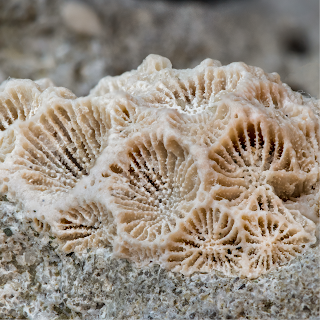 |
| Scleractinian Fossil Coral, Florida |
Corals first appeared in the Cambrian about 535 million years ago. Fossils are extremely rare until the Ordovician period, 100 million years later, when rugose and tabulate corals became widespread.
Palaeozoic corals seem to make friends wherever they live and often contain numerous endobiotic symbionts.
Tabulate corals occur in limestones and calcareous shales of the Ordovician and Silurian periods, and often form low cushions or branching masses of calcite alongside rugose corals.
Their numbers began to decline during the middle of the Silurian period, and they became extinct at the end of the Permian period, 250 million years ago.
Rugose or horn corals became dominant by the middle of the Silurian and became extinct early in the Triassic period. The rugose corals existed in solitary and colonial forms and were also composed of calcite.
The famous Great Barrier Reef is thought to have been laid down about two million years ago. If you have had the pleasure of scuba diving near it to take in its modern wonders, perhaps you will be interested to learn how it was formed. Over long expanses of time, the corals here have broken up, fragmented and died. Sand and rubble accumulate between the corals, and the shells of clams and other molluscs decay to form a gradually evolving calcium carbonate structure to what you view today.
Coral reefs are extremely diverse marine ecosystems hosting over 4,000 species of fish, massive numbers of cnidarians, molluscs, crustaceans, and many other animals.
